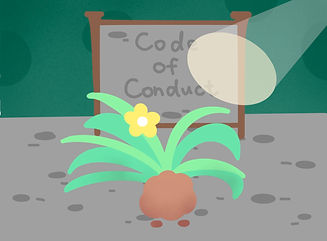Week 1 : Stop-Motion Animation
2020/10/26
This week I created two short stop-motion animations using the food had at home. I thought it would be fun to make animations with foods that look similar, so I picked orange and orange jelly candy as one group, and donut and circle candy as another group.
For the first animation, my initial idea was to simply turn a slice of orange into a orange jelly candy, but I thought adding some storytelling elements would make it more interesting, so I created this short story about me trying to catch a piece of orange. For the second animation, I created a magic trick effect that turns circle candies into a donut. The making process took me quite a long time, but I'm really happy with the results!
Week 2 : Understanding Comics Response + Storyboard
2020/11/2


About 1/3 of the books on my bookshelf are comic books. I can still remeber the excitement I felt as a kid everytime I bought the latest issue of Comic Show (a popular comic magazine in China). When I opened the magazine and read through different stories, I felt like I was traveling between parallel universes. In one universe human could live harmoniously with monsters, in another universe vampires were taking control of the world...I also became part of the story. Comics is magical to me, but I've never thought about the reasons behind. Unserstanding Comics helps me understand why it is so special.
Understanding Comics is a comic about comics by Scott McCloud. It explores comics to its core, and has tons of cool concepts and ideas. The most intriguing part for me is in chapter two and chapter three where Scott McCloud explains how comics works on our minds. He brings up the point that cartooning is a form of "amplification through simplification": when we abstract an image through cartooning, we are stripping down an image to its essential "meaning" and amplifying that meaning in a way that realistic art can't. The ability of comics to simplify characters and images toward a purpose is an important part of its special power. I'm also intrigued with the idea that the simpler the character on the page is, the easier it is for the reader to identify with the character. McCloud explains that our mind-pictures of our own bodies are simplified conceptualized images, so when we look at something as simple and basic as cartoons, we see ourselves. Through cartoons, comic artists can portray the conceptual world, where our identities and awareness belong.
In chapter three, McCloud also explores how the psychology principle of “closure” applies to comics gutters. He describes closure as, “Observing the parts, but perceiving the whole.” Although comics panels fracture both time and space, closure allows us to connect these moments and mentally construct a continuous, unified reality. By filling in the space between panels, we complicit in every act in a comic.
Understading Comics definitely gave me a new understanding and appreciation of comics. For me, the best thing about this book is the way Scott McCloud peels back the layers to see what's going on subconsciously when we read comics. Now I understand why comics is so special and powerful as a medium.
For our animation, Jingyuan and I decided to create a story about a plant character called Bobo.



Bobo is a weed that grows alongside a street. She lives with her friends who are also weeds. But unlike her friends, she has a flower on her head.
Bobo loves playing with her friends every day. They dance, sings songs, and do all kinds of stupid stuff. She is quite happy with her life. However, sometime she feels like she doesn’t belong here.
One day, a postcard fell beside her--it was a postcard of a beautiful botanic garden. She was so obsessed with the scene that she decided to go and have a look. She thought maybe the gardon was the place she belonged to.



After saying goodbye to her friends, Bobo began her journey. She kept walking day and night towards the botanic garden.
Finally, she arrived. She was so excited!
However, all the plants in the garden seemed unhappy. They told her they had to pretend normal when humans were present and couldn’t move freely as they wished.



There was even a code of conduct in the garden!
When Bobo was reading the code of conduct, a beam of a flashlight appeared.
Someone was coming. She quickly pretend to be a normal weed.
It was a security guard on night patrol. He noticed Bobo and kicked her away. The flower on Bobo's head was kicked off.

But somehow, Bobo wasn’t that sad. She left her flower at the bonatic garden, and returned back home. Now She is living happily with her friends again.
Week 4 : Animation - Bobo's Adventure
Week 6 : Cornell Box
2020/12/7
My cornell box is inspired by the Japanese animated film The Secret World of Arrietty. In the film, Arrietty is a young Borrower who lives under the floorboards of a typical household and borrows items from humans to survive. She likes collecting plants to decorate her room. For this week’s assignment, I recreated Arrietty's room in the Unreal engine.


First, I downloaded a 3d cartoon girl model and animated it in Mixamo. I also downloaded several plant and furniture models and imported them into my project. Then I created a wooden box to be Arrietty's house and placed the furniture and flowers inside. I decorated the surrounding environment with bigger plants and a bird.
The lighting in Unreal engine seemed fine, but when I exported the video it was overexposed. I tried to adjust the lighting in my project but it didn't work...
Screen Recording Video

Exported Video
